A small garden can be as attractive, low maintenance and supportive of nature as a large garden. When well designed, a small garden can be home to many species of wildlife. And when it’s in a neighborhood of small gardens, it becomes part of a larger habitat or corridor in which wildlife can live and thrive. Let’s look at some basic design concepts for small areas.
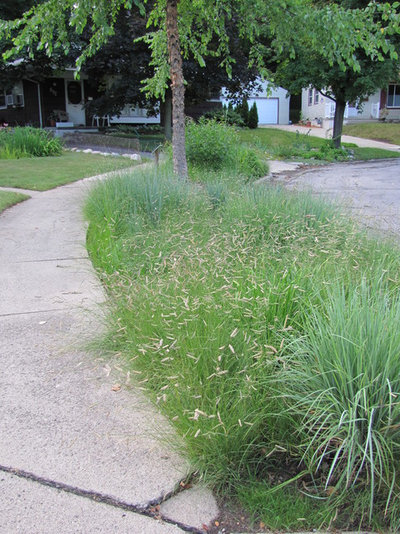
Creating Sustainable Landscapes, LLC
Let’s say you have a 100- to 200-square-foot area to work with, and you want to keep the plants under 4 feet tall so as not to visually overwhelm the space and your neighbors. You want it to look good, as though it has a designed purpose, but you also want it to help the environment, from pollinators to birds.
1. Keep it simple but plant it thick. Accept your garden’s limitations and work with them by keeping plantings simple. It’s going to look chaotic if you have 30 plant species in 100 square feet. Instead, choose 10 to 12 species, or fewer, and try to have two or three of them be a grass or sedge.
Grasses and sedges provide winter shelter and nesting material for birds, and they tend to outcompete weeds with their fibrous root systems and soil-shading nature. These will become your base layer that ties everything together in a cohesive way. Match them to your soil, light conditions and ecoregion for best long-term performance. Grasses generally need full sun, whereas sedges are more adaptable.
Sideoats grama (
Bouteloua curtipendula,
USDA zones 3 to 9; find your zone), prairie dropseed (
Sporobolus heterolepis, zones 3 to 8), little bluestem (
Schizachyrium scoparium, zones 2a to 9b) and sedges like Sprengel’s sedge (
Carex sprengelii, zones 3 to 5) or Muskingum sedge (
C. muskingumensis, zones 4 to 9), also called palm sedge, are good options.
Plants shown:
Little bluestem, hairy grama (
Bouteloua hirsuta), blue grama (
B. gracilis), sideoats grama and prairie dropseed
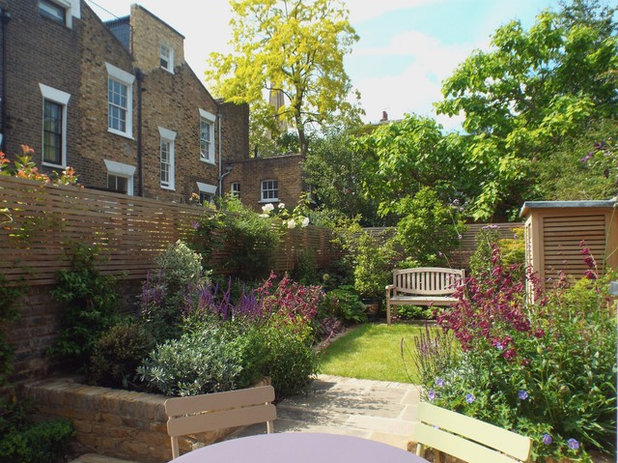
Jenny Bloom Garden Design
2. Mass flowers. In 100 square feet, you could include four to six species of flowering perennials, planted in clumps of two to three. Planting in clumps not only helps the landscape look organized, but it also serves as a stronger beacon for pollinators flying overhead. If you want the space to be more formal, place shorter plants toward the front of the design and taller ones toward the back. You can also mix and match for a more natural appearance, with the mass plantings helping to avoid a messy look.
Think about including plants that will provide you with blooms throughout the year. Consider dwarf false indigo (
Amorpha nana,
zones 3 to 7) for mid- to late spring, purple (
Echinacea purpurea,
zones 3 to 8
) or pale purple coneflowers (
E. pallida, zones 3 to 10) for midsummer and smooth aster (
Symphyotrichum laeve, zones 4 to 8), skyblue aster (
S. oolentangiense, zones 3 to 8) or calico aster (
S. lateriflorum, zones 5 to 9) for fall.
Plants shown (click photo to see the plants tagged): ‘Blackbird’ penstemon (
Penstemon ‘Blackbird’), ‘Caradonna’ sage (
Salvia nemorosa ‘Caradonna’),
‘Rozanne’ cranesbill (
Geranium ‘Rozanne’), bush morning glory (
Convolvulus cneorum)
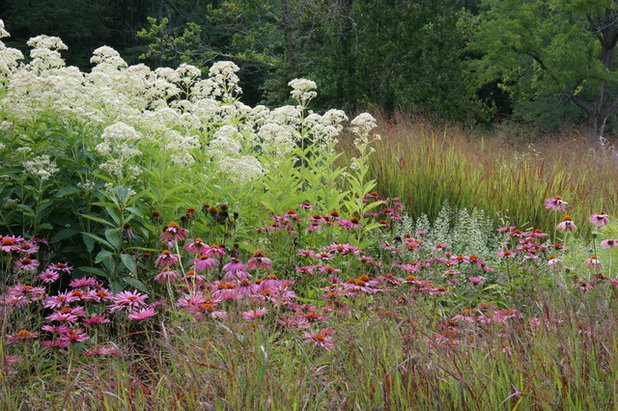
Adam Woodruff + Associates, Garden Artisans
3. Bring in architectural plants for winter interest. The aforementioned asters have showy bracts. The grasses and sedges will have winter foliage, and some will hold on to their seeds a long while. Additionally, a rattlesnake master (
Eryngium yuccifolium,
zones 3 to 8), or three, would contribute winter interest — it’s a great pollinator nectar source with cool globes in winter. I’m also a fan of roundhead lespedeza (
Lespedeza capitata, zones 3 to 9); even though its flowers aren’t showy, it looks good well into the next spring. One red milkweed (
Asclepias incarnata, zones 3 to 9) or butterfly milkweed (
A. tuberosa,
zones 3a to 10b) could work too. This brings us up to roughly 10 plant species, which gives you some wiggle room to add one or two sentimental favorites.
You could also place a small shrub somewhere — maybe a Saskatoon serviceberry (
Amelanchier alnifolia,
zones 3 to 9), lead plant (
Amorpha canescens,
zones 3 to 9) or New Jersey tea (
Ceanothus americanus,
zones 4 to 9). If there’s room against the property edge, consider a small tree — something with spring flowers for pollinators and fall or winter fruits for birds. Chokecherry (
Prunus virginiana, zones 2 to 7), crabapples (
Malus spp.) and redbuds (
Cercis spp.) are suitable.
Plants shown (click photo to see the plants tagged): ‘Ruby Star’ coneflower (
Echinacea purpurea ‘Ruby Star’), ‘Shenandoah’ switchgrass (
Panicum virgatum ‘Shenandoah’), ‘Bartered Bride’ Joe Pye weed (
Eupatorium maculatum ‘Bartered Bride’)
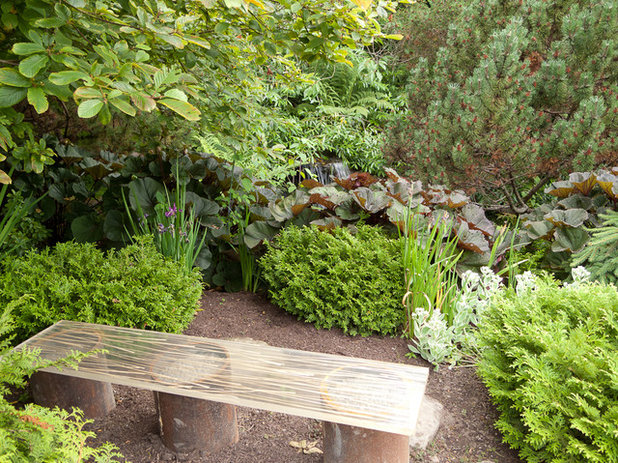
Le jardinet
4. Create a path. Mulch works great, or you could dig in some steppingstones. Maybe you can place a birdbath with a narrow or small footprint in there too. Even a little bench nestled among the plants would show that the space is made for bridging the world of humans and other species, making it inviting to all.
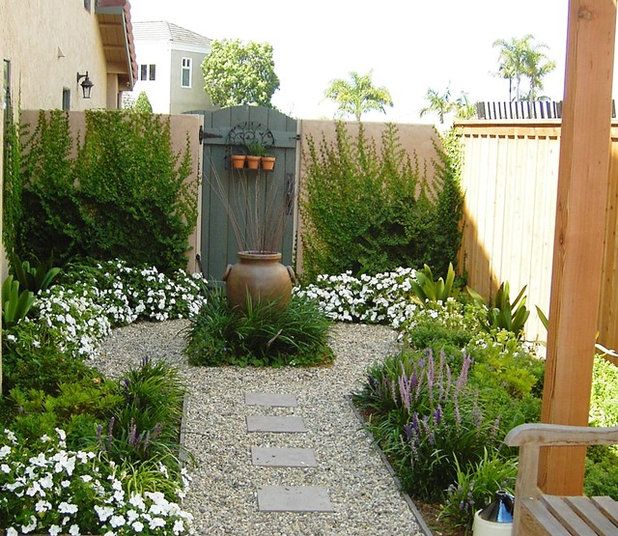
debora carl landscape design
If you put everything together, you have a garden that’s doing many things for wildlife:
- Grass provides birds with nesting material and insects to eat.
- Moths and butterflies lay their eggs on milkweed, asters, coneflowers, wild indigo and grasses.
- Flowers provide pollen and nectar to pollinators.
- Ornamental seed heads create winter interest.
- A thick planting scheme of grasses and sedges combats weeds.
All told, you may have roughly 50 plants in a 100-square-foot bed, depending on if you have a path and how wide it is. If you can buy plugs or 3-inch pots, you may spend in the neighborhood of $250 to $350 on the plant material.





